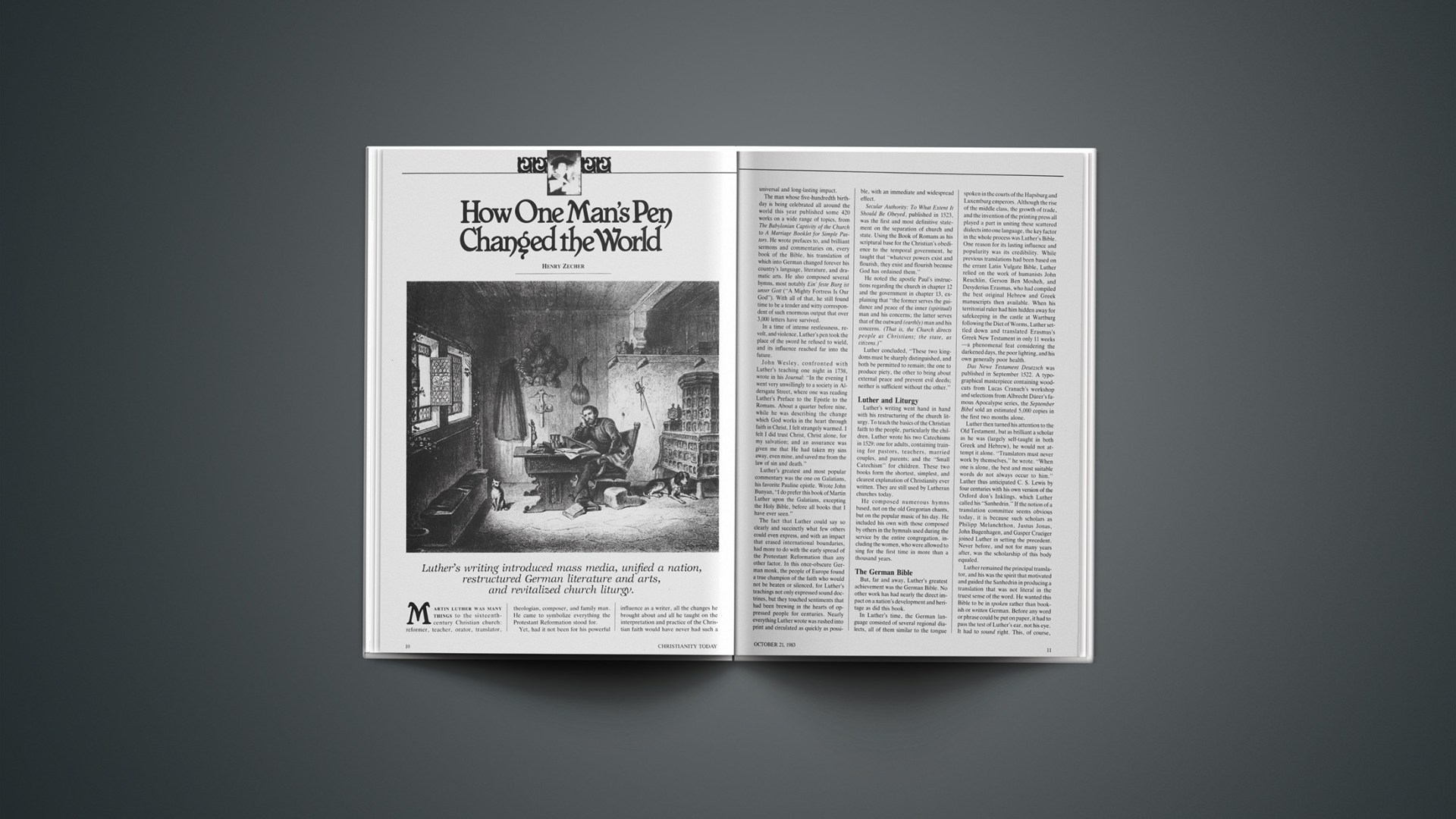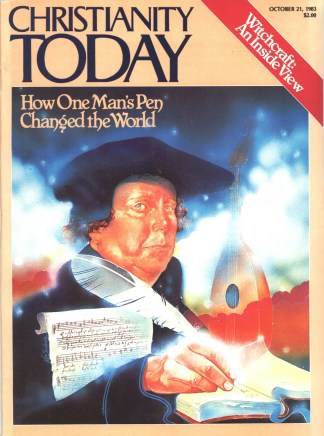Luther’s writing introduced mass media, unified a nation, restructured German literature and arts, and revitalized church liturgy.
Martin luther was many things to the sixteenth-century Christian church: reformer, teacher, orator, translator, theologian, composer, and family man. He came to symbolize everything the Protestant Reformation stood for.
Yet, had it not been for his powerful influence as a writer, all the changes he brought about and all he taught on the interpretation and practice of the Christian faith would have never had such a universal and long-lasting impact.
The man whose five-hundredth birthday is being celebrated all around the world this year published some 420 works on a wide range of topics, from The Babylonian Captivity of the Church to A Marriage Booklet for Simple Pastors. He wrote prefaces to, and brilliant sermons and commentaries on, every book of the Bible, his translation of which into German changed forever his country’s language, literature, and dramatic arts. He also composed several hymns, most notably Ein’ feste Burg ist unser Gott (“A Mighty Fortress Is Our God”). With all of that, he still found time to be a tender and witty correspondent of such enormous output that over 3,000 letters have survived.
In a time of intense restlessness, revolt, and violence, Luther’s pen took the place of the sword he refused to wield, and its influence reached far into the future.
John Wesley, confronted with Luther’s teaching one night in 1738, wrote in his Journal·. “In the evening I went very unwillingly to a society in Aldersgate Street, where one was reading Luther’s Preface to the Epistle to the Romans. About a quarter before nine, while he was describing the change which God works in the heart through faith in Christ, I felt strangely warmed. I felt I did trust Christ, Christ alone, for my salvation; and an assurance was given me that He had taken my sins away, even mine, and saved me from the law of sin and death.”
Luther’s greatest and most popular commentary was the one on Galatians, his favorite Pauline epistle. Wrote John Bunyan, “I do prefer this book of Martin Luther upon the Galatians, excepting the Holy Bible, before all books that I have ever seen.”
The fact that Luther could say so clearly and succinctly what few others could even express, and with an impact that erased international boundaries, had more to do with the early spread of the Protestant Reformation than any other factor. In this once-obscure German monk, the people of Europe found a true champion of the faith who would not be beaten or silenced, for Luther’s teachings not only expressed sound doctrines, but they touched sentiments that had been brewing in the hearts of oppressed people for centuries. Nearly everything Luther wrote was rushed into print and circulated as quickly as possible, with an immediate and widespread effect.
Secular Authority: To What Extent It Should Be Obeyed, published in 1523, was the first and most definitive statement on the separation of church and state. Using the Book of Romans as his scriptural base for the Christian’s obedience to the temporal government, he taught that “whatever powers exist and flourish, they exist and flourish because God has ordained them.”
He noted the apostle Paul’s instructions regarding the church in chapter 12 and the government in chapter 13, explaining that “the former serves the guidance and peace of the inner (spiritual) man and his concerns; the latter serves that of the outward (earthly) man and his concerns. (That is, the Church directs people as Christians; the state, as citizens.)”
Luther concluded, “These two kingdoms must be sharply distinguished, and both be permitted to remain; the one to produce piety, the other to bring about external peace and prevent evil deeds; neither is sufficient without the other.”
Luther And Liturgy
Luther’s writing went hand in hand with his restructuring of the church liturgy. To teach the basics of the Christian faith to the people, particularly the children, Luther wrote his two Catechisms in 1529: one for adults, containing training for pastors, teachers, married couples, and parents; and the “Small Catechism” for children. These two books form the shortest, simplest, and clearest explanation of Christianity ever written. They are still used by Lutheran churches today.
He composed numerous hymns based, not on the old Gregorian chants, but on the popular music of his day. He included his own with those composed by others in the hymnals used during the service by the entire congregation, including the women, who were allowed to sing for the first time in more than a thousand years.
The German Bible
But, far and away, Luther’s greatest achievement was the German Bible. No other work has had nearly the direct impact on a nation’s development and heritage as did this book.
In Luther’s time, the German language consisted of several regional dialects, all of them similar to the tongue spoken in the courts of the Hapsburg and Luxemburg emperors. Although the rise of the middle class, the growth of trade, and the invention of the printing press all played a part in uniting these scattered dialects into one language, the key factor in the whole process was Luther’s Bible.
One reason for its lasting influence and popularity was its credibility. While previous translations had been based on the errant Latin Vulgate Bible, Luther relied on the work of humanists John Reuchlin, Gerson Ben Mosheh, and Desyderius Erasmus, who had compiled the best original Hebrew and Greek manuscripts then available. When his territorial ruler had him hidden away for safekeeping in the castle at Wartburg following the Diet of Worms, Luther settled down and translated Erasmus’s Greek New Testament in only 11 weeks—a phenomenal feat considering the darkened days, the poor lighting, and his own generally poor health.
Das Newe Testament Deutzsch was published in September 1522. A typographical masterpiece containing woodcuts from Lucas Cranach’s workshop and selections from Albrecht Dürer’s famous Apocalypse series, the September Bibel sold an estimated 5,000 copies in the first two months alone.
Luther then turned his attention to the Old Testament, but as brilliant a scholar as he was (largely self-taught in both Greek and Hebrew), he would not attempt it alone. “Translators must never work by themselves,” he wrote. “When one is alone, the best and most suitable words do not always occur to him.” Luther thus anticipated C. S. Lewis by four centuries with his own version of the Oxford don’s Inklings, which Luther called his “Sanhedrin.” If the notion of a translation committee seems obvious today, it is because such scholars as Philipp Melanchthon, Justus Jonas, John Bugenhagen, and Gasper Cruciger joined Luther in setting the precedent. Never before, and not for many years after, was the scholarship of this body equaled.
Luther remained the principal translator, and his was the spirit that motivated and guided the Sanhedrin in producing a translation that was not literal in the truest sense of the word. He wanted this Bible to be in spoken rather than bookish or written German. Before any word or phrase could be put on paper, it had to pass the test of Luther’s ear, not his eye. It had to sound right. This, of course, was the German Bible’s greatest asset, but it meant that Luther had to straddle the fence between the free and the literal.
“It is not possible to reproduce a foreign idiom in one’s native tongue.” he wrote. “The proper method of translation is to select the most fitting terms according to the usage of the language adopted. To translate properly is to render the spirit of a foreign language into our own idiom. I try to speak as men do in the market place.”
The translators used the court tongue as their base language but flavored it with the best of all the dialects they could find in the empire. Ever the relentless perfectionist who might spend a month searching out a single word, Luther talked at length with old Germans in the different regions. He called on local craftsmen and studied their tools, and had the town butcher cut up sheep so he could study their entrails. When he ran into the precious stones in the “new Jerusalem” that were unfamiliar to him, he had similar precious stones from the elector’s collection brought up for him to study, along with explanations of their names.
It was Luther’s desire to express the original Hebrew in the best possible German, but the task was not without its difficulties. “We are now sweating over a German translation of the Prophets,” he wrote. “O God, what a hard and difficult task it is to force these writers, quite against their wills, to speak German. They have no desire to give up their native Hebrew in order to imitate our barbaric German. It is as though one were to force a nightingale to imitate a cuckoo, to give up his own glorious melody for a monotonous song he must certainly hate. The translation of Job gives us immense trouble on account of its exalted language, which seems to suffer even more, under our attempts to translate it, than Job did under the consolations of his friends, and seems to prefer to lie among the ashes.”
In spite of this, the Sanhedrin worked rapidly but accurately, translating in a tone more apologetic than scientific. The result was a German Bible of such incomparable literary quality that those competent to say so consider it superior even to the King James Version that followed it. And because it sounded natural when spoken as well as read, its cadence and readability have made it the most popular Bible in Germany to this day.
The German Bible’S Impact
Germans everywhere bought it, not only for the salvation of their souls (if such was their concern), but also for the new middle-class prestige it conferred. It was the must book to have in their homes, and many Germans had no choice but to read it because it was likely to be one of the few books they could afford to buy.
It was the first time that a mass medium, in the form of the printed word, had ever penetrated everyday life. Everyone read it or listened to it being read. Its phrasing became the people’s phrasing, its speech patterns their speech patterns. So universal was its appeal, and so thoroughly did it embrace the entire range of the German tongue, that it formed a linguistic rallying point for the formation of the modern German language and a more formal restructuring of German literature and the German performing arts. Its impact, and Luther’s in general, were so awesome that Frederick the Great later called Luther the personification of the German national spirit, and scholars today consider him the most influential German who ever lived.
As might be expected, the German Bible’s impact reached well beyond the borders of the empire. It was the direct source for Bibles in Holland, Sweden, Iceland, and Denmark. Its influence was felt in many other countries as well, but most important was the permanent impression it left on the first great translator of the English Bible.
William Tyndale, one of the Reformation’s greatest champions, had fled from England to the Continent about the time Luther was publishing his German New Testament. He, too, was engaged in translating from the original manuscripts, and he and Luther are believed to have met in Wittenberg.
Among the many strong points of Luther’s work that impressed Tyndale was the order the German gave to the books of the New Testament. There had never been any uniform arrangement of these books in previous Bibles, and earlier translators had simply placed them in whatever order suited them.
Luther, however, ranked them by the yardstick of was treibt Christus—how Christ was taught: the four Gospels (Matthew, Mark. Luke, and John); the Acts of the Apostles; the Epistles, in descending order of the Savior’s prominence in each; and, finally, the Revelation of John. Subsequent research has confirmed Luther’s choice, and Tyndale followed it almost without question, as have all Bible translators since.
Many of the phrases we know today came from Luther through Tyndale. From the German’s natürlich, Tyndale wrote natural, and the phrase natural man appeared in 1 Corinthians 2:14. Luther’s auf dem gebirge became was a voice heard in Matthew 2:18. Tyndale translated from Luther the place of men’s skulls in John 19:17. Ye vex yourselves off a true meaning in 2 Corinthians 6:12, Doctors in the Scripture in 1 Timothy 1:7, and hosianna in Matthew 21:15. Like Luther, Tyndale eschewed the Latinized ecclesiastical terms in favor of those applicable to his readers: repent instead of do penance; congregation rather than church; Savior or elder in the place of priest; and love over charity for the Greek/Christian agape.
Both translations flowed freely in a rhythm and happy fluency of narration; and, wherever he could, Tyndale upheld Luther’s doctrine of justification by faith. While there were certainly many instances where the two men must have reached the same conclusions independent of each other, Luther’s strong influence on the father of the English Bible is unmistakable. Considering the fact that Tyndale’s English translation makes up more than 90 percent of the King James New Testament and about 80 percent of the Revised English Version, Luther’s legacy is plain to see.
Luther was exceptionally gifted in most everything he did, but that aspect of his genius most responsible for the impact he had is the one least heralded through the centuries—his skill and power as a writer. Had it not been for that, the Protestant Reformation and the growth of a united German nation would have taken an entirely different course.










